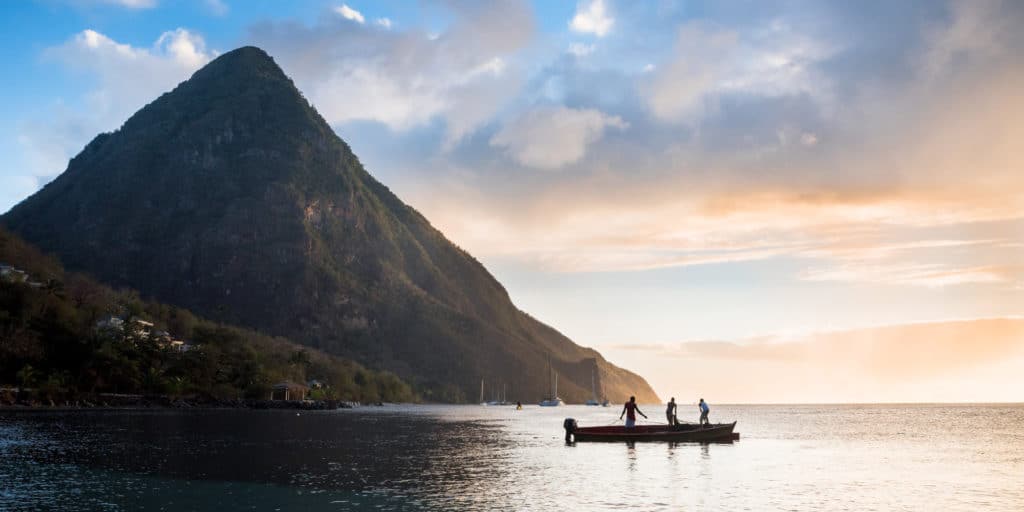
Korina, our 48-foot Moorings charter catamaran, had been moored for the better part of a day behind Horseshoe Reef, in the Tobago Cays, last February when shipmate and photographer Cate Brown and I clambered into the dinghy for a brief morning photo safari around the choppy anchorage. As soon as I put the outboard in gear and began to motor ahead, I was splashed with spray and thought to myself, “Can’t that wind just stop blowing for a minute?”
Then I remembered: I’d pondered the very same question 10 years earlier, when other friends and I had anchored a charter boat in nearly the same spot, next to Baradel Island and its sea turtle sanctuary. On that trip, the cays were my favorite part. I’d never before seen anything that matched the shimmering blue water, sun-bleached beaches, or the way the Milky Way filled the night sky. But it was the wind that really got me: the glorious trades that blew incessantly, singing in the rigging and drowning out the roar of the Atlantic swells crashing on the 2.5 miles of coral reef that protect the five islands of the Tobago Cays Marine Park, the crown jewel of the Grenadines.
On that first trip, my mates and I had bounced around between Bequia to the north and Union Island to the south, starting from and returning to a now-closed charter base in Canouan. It had been a grand adventure, to be sure, but this past winter’s was even better, because instead of short passages between stopovers, we got to sail long stretches between the islands as we made a 120-nautical-mile downwind dash from The Moorings’ base on St. Lucia south to Grenada, where we left the boat for someone else to sail the long beat back.
How very civilized.
There were four of us sharing this little adventure. Cate and I, both from ice-encrusted New England, were joined at the international airport in Vieux Fort by The Moorings’ general manager, Josie Tucci, and my Annapolis sailing pal Dave Robinson. Though we’d all arrived right on time, any chance for an afternoon departure that day was dashed by traffic on the way to The Moorings’ base in Rodney Bay and last-minute repairs to Korina.
Instead of fretting, we chilled. We took advantage of the boat’s downtime to enjoy a much-appreciated rum punch by the pool, stow provisions, and get our briefing out of the way. Shuffling between charts and cruising guide, base manager Lene Voney explained the finer points of dealing with customs in St. Lucia; clearing into the Grenadines at Bequia and out at Union Island; and then clearing in again in Carriacou at Tyrrel Bay, the first port of entry we’d reach in the island nation of Grenada. To accomplish all that, Lene advised a trip to the ATM, which was stocked with Eastern Caribbean dollars. We should depart with no less than 1,110 XCD ($400 USD) in cash, she said, and with at least 16 copies of our crew list, all of which would eventually be handed over to various agents along the way.
We had eight days to reach St. George’s, on Grenada’s south coast. It seemed like plenty of time to get a taste of what the Windward Islands hold for sailors, but we’d still need to be on the move daily if we wanted to get Korina there on time.
Let the Fun Begin
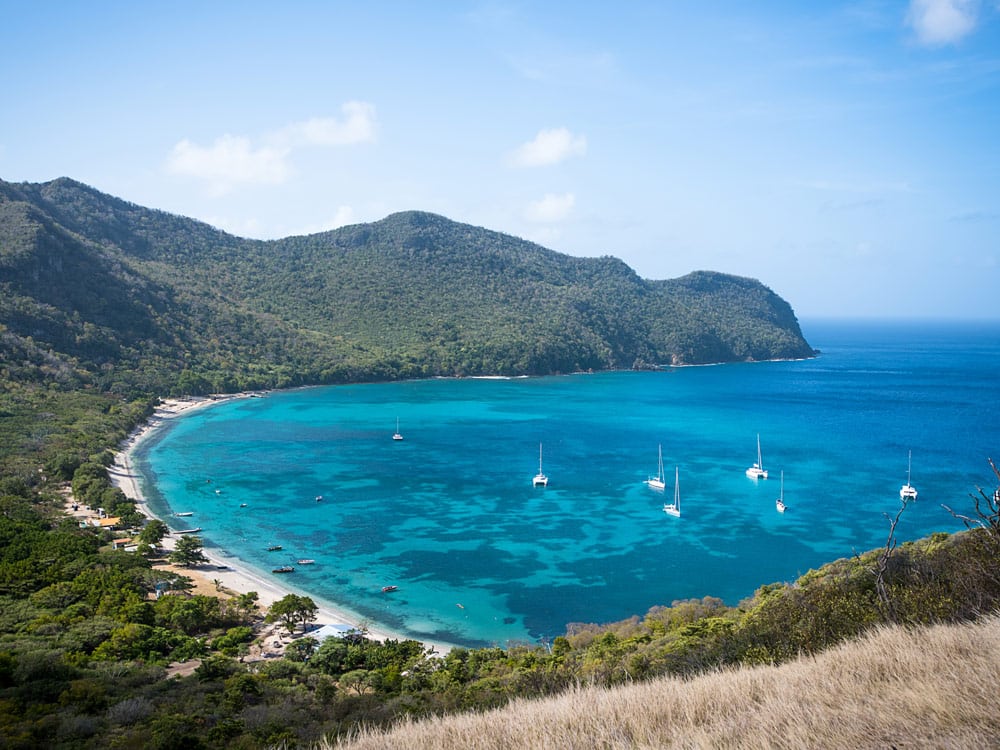
Though we planned a breakfast departure for the next day’s sail to the iconic Pitons, the twin rock spires that tower over St. Lucia’s southwestern coast, it was closer to beer-and-sandwich time when we finally coiled our dock lines. Outside, we found plenty of breeze and tucked one reef in the main before taking full advantage of the boat’s electric winch to set sail. Underway at last, we bore away, rolled out the jib, and tailed its starboard sheet home. With the wind just aft of the beam, Korina sprang to life at 7 knots, and we were off. We didn’t know it then, but that reef would remain in the main for the duration of our trip, and the port jib sheet would stay coiled and in the line bag for all but two short intervals: when we needed to jibe away from shore to find better wind, and on one brief occasion on the last day when we found ourselves beating back to the base with the wind at 40 degrees apparent. Like I said, the sailing really was quite civilized.
By midafternoon, our maiden voyage was complete, and it was time to round up and drop the sails. What luck — there was one last open mooring to grab, and it was smack-dab between the Pitons. As we motored up to it, we encountered our first boatboy. These watermen are a fact of life throughout the Windward Islands, and many can be quite helpful, providing visitors with provisions and local knowledge on anchoring and sights ashore. If you politely decline their services, most will leave you alone, though some can be pushy, and a few downright irritating.
In this case, without asking, a fellow called “Safe Speed” swept in with his dinghy and handed up the loop on the mooring’s pendant line, through which we needed to pass dock lines to secure to cleats on each hull. His work done, he then pulled up astern and said the charge for the night in the marine park would be $50.
RELATED: The Lovely Leeward Islands: Something for Everyone
We’d been advised to avoid scams by always asking for a receipt for services and inquiring ahead of time if fees were in U.S. dollars or Eastern Caribbean currency (with an exchange rate of about 2.7 XCD per $1). Safe Speed assured us a colleague would be along with the requested receipt and waited patiently to be paid. Civil bartering ensued, and in the end, he settled for 20 XCD and a cold Coke for his assistance with the mooring. Later, a park ranger collected the 54 XCD mooring fee. I mention the transaction because it was repeated in some variation in nearly every harbor.
Our bills settled, I wasted no time in donning mask, snorkel and fins and paid a visit to the local sea creatures. Then, with an hour of daylight left, we launched the dinghy and went ashore to the well-maintained Sugar Beach Resort for sundowners. Later aboard Korina, we feasted on grilled fish and vegetables. And as the moon rose over the ridge between the peaks, we toasted a first day well spent. We were now right back on schedule.
Taste of the Trades
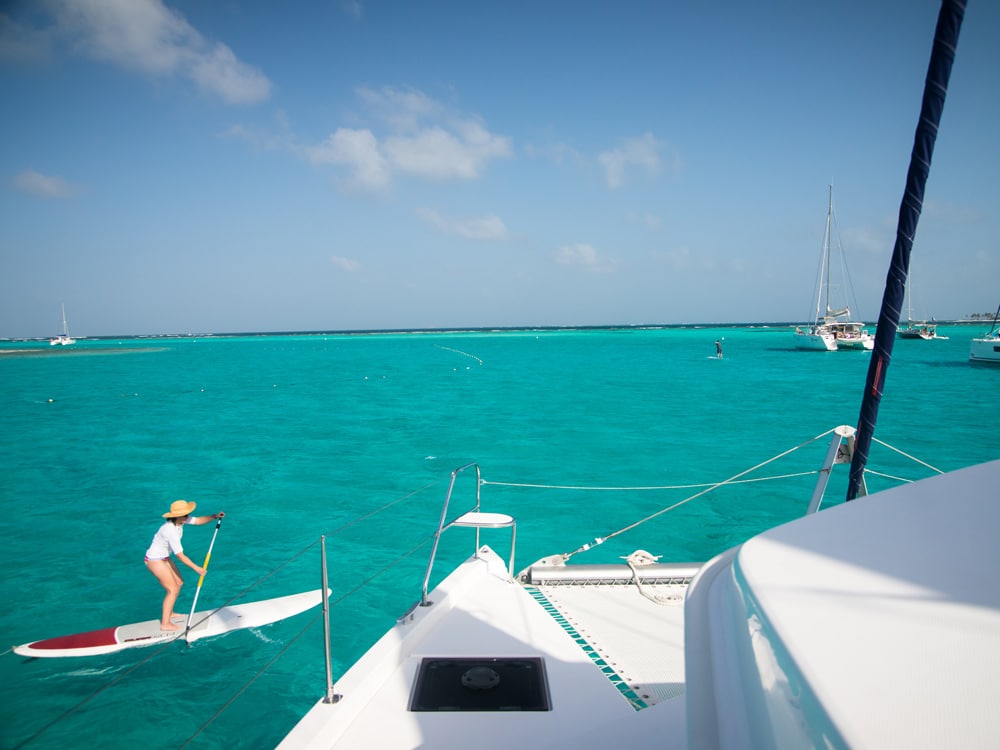
In the morning, we were off at 0600. Still in the lee of St. Lucia, we motorsailed until the first of the trade winds filled the main. In no time, we were in open water and steering for a waypoint roughly 10 degrees east of the tip of St. Vincent to allow for westerly set. The breeze was steady at first, in the high teens, but then conditions became more boisterous, with gusts nearing 30 as we neared the top of St. Vincent. As we closed on land, the waves built and steepened, and Korina turned from comfy cat to sporty surfer. With a rush, she’d surge forward, the speedo climbing from the mid-8s to 9 knots, then to 10, and once or twice to nearly 14 knots as one swell passed and the next lifted the stern anew. Heavens, it was fun.
Ashore, St. Vincent’s Soufriere volcano was covered in clouds, and the hills were a lush rainforest green. As we reached along, we encountered a steady stream of charterers motorsailing northward close to shore, headed for home. Poof: The whole one-way concept became crystal clear.
Eager to get to Bequia and have the afternoon to visit bustling Port Elizabeth, we motored briefly to find clear breeze. Then, as we swept past St. Vincent’s southern tip and Blue Lagoon, we hardened sheets and made the crossing to Admiralty Bay on one tack. Had we had days to laze about, I think I’d have enjoyed spending a few exploring Bequia, where locals still hunt for whales and yachtsmen congregate to relax and re-provision. Ashore, the streets were abuzz with vendors hawking their artwork and clothing, and numerous cafes promised fine dining. But to be honest, I hadn’t come to shop, and we had more than enough food aboard. This early into the trip, I was much more intrigued by the idea of coral reefs, lonely anchorages and windblown beaches — all of which we found the very next day, when we pushed on toward the heart of the Grenadines.
Cays, Palms and Rum
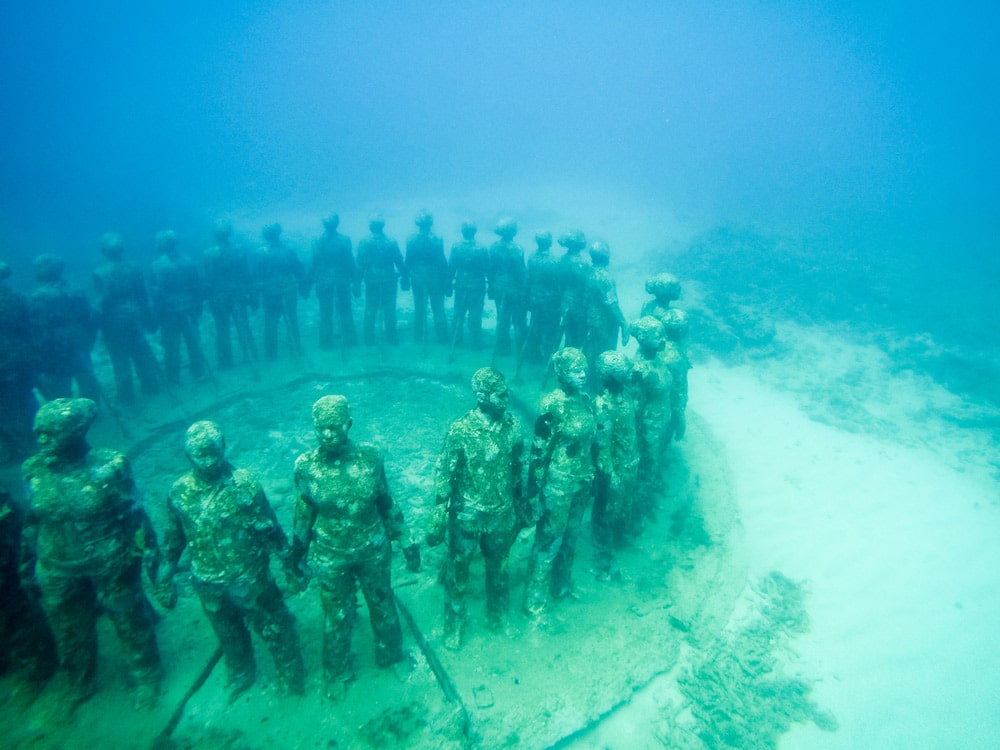
The next morning, after another visit to town, we rode 20-knot trade winds toward Canouan, just visible in the mist. Beyond, the remainder of the Grenadines blended into a patchwork of dark shapes that only slowly began to distinguish themselves as we covered the next 20 or so nautical miles to our destination: Salt Whistle Bay and its half-moon-shaped, palm-lined beach at the northern end of Mayreau, the gateway to the Tobago Cays. Entering the bay under power, we heeded the reefs to either side. We were greeted by “Black Boy,” owner of the brightly colored beach bar of the same name, who pointed out a spot to anchor. At his establishment ashore, we tested his claim of having the best rum punch in the Caribbean, and I regrettably agreed to try a sip of one of his colleagues’ Sunset Very Strong Rum. The name speaks for itself.
Said rum took its toll on Black Boy’s team, and unfortunately none of them were available later that afternoon, when it turned out our choice anchoring location was too close to another boatboy’s mooring — one that was now in demand by a newly arrived sailboat. In the end, we moved, but by the time we did, the bay was crowded enough that the only spot we could find was uncomfortably close to a reef to port and a boat full of Frenchmen to starboard. To this day, I have no idea what the animated skipper said, but judging from his gestures, I’m fairly sure he wasn’t pleased to have us so near.
Turns out reefs and French yachts were the least of our worries. What came to haunt us in Salt Whistle Bay were the bats.
Let me explain.
Dave and I stayed on deck well into the night to make certain all remained fine between us and the neighbors. Finally convinced we wouldn’t collide, I headed to my cabin below and Dave dozed off in the cockpit. Just after dawn, I awoke from what had seemed like a restless sleep and realized something was askew. Sitting up, I spotted dark stains everywhere, and at first thought it might be ashes that had blown in from a campfire ashore.
Then I headed up to the saloon, where I found a round-eyed Dave. He kept repeating, “The bats … the bats.”
We theorized that the little devils must have smelled the bananas and other fruit we had stashed in the galley, and during the night they decided to invite themselves to dinner. Being a considerate crewmate, rather than scream and awaken the rest of us (as I would have), Dave tried to shoo them out with a towel and blanket. But as soon as he’d get them out the aft door, they’d circle around and come back in the forward door that Robertson and Caine builds into the Moorings 4800 for access to the foredeck. Finally, impending daylight did what Dave could not, and the bats fled, only to be replaced by a flock of birds hellbent on devouring the fruit seeds that were left behind.
And so this day in paradise began as though in a Hitchcock film as we scrubbed guano off every bulkhead, counter, and inch of cabin sole.
Our reward, however, lay just around the corner. By midmorning we were tied to a mooring and swimming with the sea turtles of the Tobago Cays. We spent the afternoon snorkeling on the reef and then had a feast of lobsters barbecued on the beach by Capt. Asbert Ashton as the sun set. It was truly a hell-to-heaven experience.
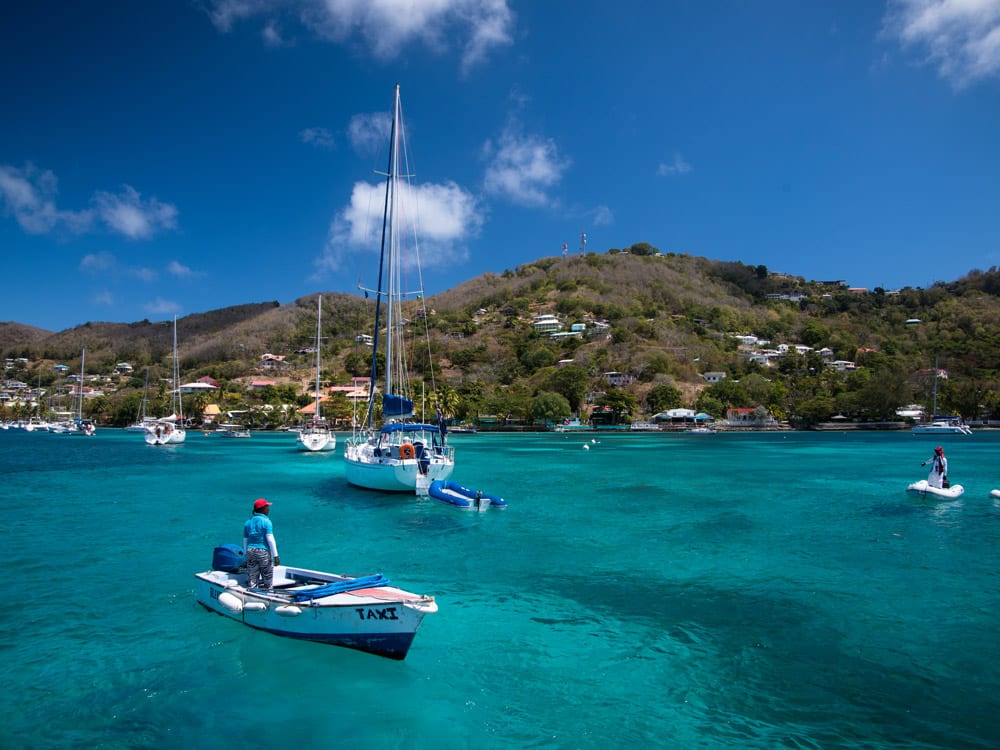
Union Island was our next stop. The first order of business was to pay a visit to the customs office in Clifton to clear out, and then we headed around the southern tip of the island to Chatham Bay, which I’d nominate as one of the most beautiful spots on the planet. On either side, steep, wooded hills tumble to the water, and a long and perfect white sand beach sits dead in the middle. Josie and Dave had a siesta, and Cate and I went snorkeling. It was a hoot watching pelicans dive-bomb the schools of fish teeming along the shore, and I loved seeing the blue-footed boobies taking it all in from their rock-top perches. Just before sunset, we went ashore and visited Sunbeach and Eat, the most prosperous-looking of the handful of beach bars, run by Seckie and Venessa.
Seckie recommended a morning hike up the rutted dirt road behind his establishment. Before the day became hot, we followed his advice and climbed steadily for a half-mile or so before we reached the ridge above. What a view westward, out across the open Caribbean. Standing in a grassy clearing and taking it all in, we were startled by the approach of a grizzled fellow clad in a red polo shirt, shorts and knee-high boots. He led a monster of a goat on a rope and slapped a long, menacing machete against his calf as he walked. But it turns out Bushman was all smiles and friendly banter once we’d said hello. And had we not met him, we’d have missed the walk along the heights to the other side, where the view of the Grenadines to the north and Grenada to the south is beyond spectacular.
Our march southward next brought us to Carriacou and Tyrrel Bay. After the transient anchorages of the Grenadines, this port was clearly a place many a cruiser called home. It had a laid-back feel to it despite a busy shipyard and marina and a long row of shops that lined the road along the beach. After clearing in, we walked nearly the length of the town and back again. I quickly discovered that if you paid any attention at all to any of the local hounds, you found a friend that would follow after you and gladly lie at your feet in the shade of a rum shop’s table, in the hopes a scrap of something might fall to the floor. It was a colorful harbor and one I’ll visit again should I get the chance.
But now our time was running short. We had 14 miles of open ocean to cross to fetch the north shore of Grenada, and then two or three more hours of sailing to reach St. George’s. Along the way, we stopped to go snorkeling at the Molinere Underwater Sculpture Park, the handiwork of British artist Jason deCaires Taylor. With directions from a local boatboy, we were able to locate many of the sunken figures. Some were standing in rings to signify life, while others lay flat to imitate death. We spotted a praying Jesus, a fertility god and several other objects that had been carefully placed in sandy areas maybe 15 to 20 feet deep.
Though we had Korina for another couple of days, Josie had to jump ship early, so we spent our first night in Grenada in a slip at The Moorings’ base at the modern Port Louis Marina. By dinghy, we visited downtown St. George’s and stopped for dinner at BB’s Crabback Caribbean Restaurant. If you get to visit, the jerk chicken and curried goat are tremendous, but don’t miss the crabback — meat that’s plucked from land crabs and cooked with herbs, wine and cheese before it’s stuffed back into the shells.
I’d like to say we were up with the sun to send Josie on her way, but that would not be entirely true. Her flight was zero-dark-thirty early. The rest of us got a slow start. I made a run by dinghy to the nearby market to grab enough food and drink for one more day’s worth of adventures, and then Dave, Cate and I headed back out, sailing past Grand Anse to explore the coves along Grenada’s south shore. Our destination was Mount Hartman Bay. Despite dire warnings about the approach, we found the winding entrance through the bay’s offshore reef both easily visible and well buoyed. Inside, there was plenty of room to anchor in the dead-calm lagoon. We swam, went exploring in the tender, and that night caught up with old friends of mine from Maine, who’d spent the winter going nowhere fast in the southern Caribbean. They came to Korina for dinner. Afterward, we loaded our remaining supplies into their dinghy. Their plans were to keep sailing; ours were to head home. Even the best sailing vacation — and this had been an exceptionally fine one — must come to an end. My only lingering question as we headed for the airport: Where to next?
Mark Pillsbury is Cruising World’s editor.








